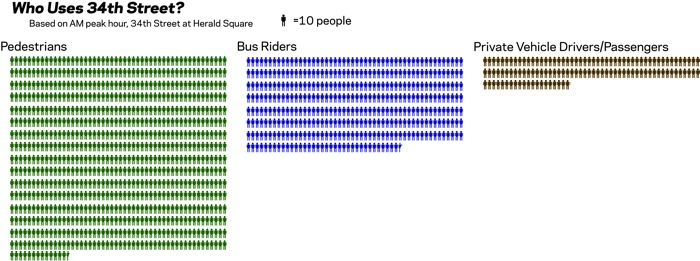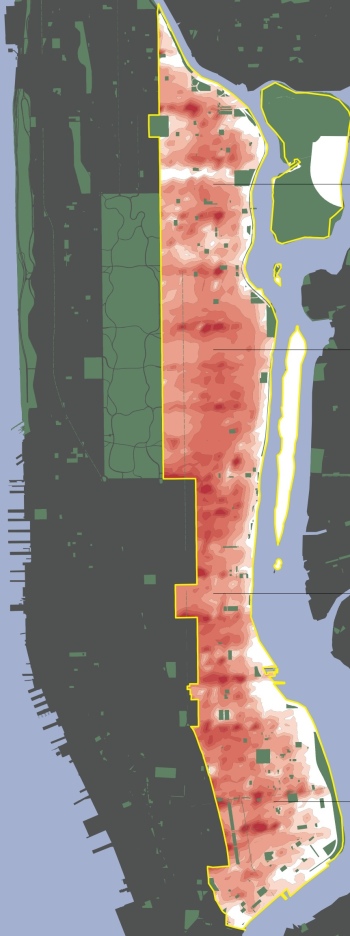Dysfunction Rules at CB 6 Discussion of Select Bus Service
 Manhattan CB 6 could have used this reminder of who actually uses 34th Street. Graphic: NYCDOT
Manhattan CB 6 could have used this reminder of who actually uses 34th Street. Graphic: NYCDOT Last night’s meeting of Manhattan Community Board 6’s transportation committee was a reminder of how opaque and undemocratic New York City’s public review process can be, at its worst. Between a mismanaged meeting that descended into chaos and a parade of NIMBYs who ensured that neither plans for First and Second Avenues nor for 34th Street could be discussed on the merits, it’s hard to see how last night’s proceedings contributed to an informed discourse about New York City’s transportation needs.
The night was marred by a series of procedural irregularities, which riled up an already restive crowd. During discussion of a resolution in support of Select Bus Service and safety improvements on First and Second Avenues, two committee members proposed an amendment in favor of adding buffered bike lanes to fill gaps in the physically-protected bike route proposed for the corridor.
When Fred Arcaro, the committee chair, declared that the amendment failed 6-5, a combination of whispers and shouts filled the room. Some at the meeting, including committee members, felt that there had been a miscount and that the amendment had actually passed. When I followed up with Arcaro today, he said that the amendment officially failed 8-6.
Arcaro also informed me that the public isn’t entitled to see the text of community board resolutions until they are passed by the full board. Until then, he said, they could still be amended. When I asked how non-members are supposed to participate in these public meetings without knowing what is being discussed, Arcaro said only, "listen carefully." The meeting was constantly interrupted by shouts from the audience and even from committee members seeking information or trying to set the record straight. Perhaps more open information might have kept the rowdy crowd a bit happier.
Overall, the meeting was less an exercise in participatory democracy than a lopsided forum for purely parochial concerns.
 CB 6 could also have used a reminder of how many people get injured along First and Second Avenues every year. Image: Transportation Alternatives.
CB 6 could also have used a reminder of how many people get injured along First and Second Avenues every year. Image: Transportation Alternatives.The discussion of Select Bus Service along First and Second never mentioned the 58,000 New Yorkers who ride the M15 bus each day and barely touched on the cyclists and pedestrians whom the redesign would keep safe. The discussion didn’t even include the effect on vehicular traffic.
Rather, Community Board 6 spent its time discussing who will get a bus stop where. Members of the Turtle Bay Association and a local group that calls itself the "Sutton Area Community" stood up to decry the lack of an SBS stop at 50th Street, a stop which MTA planners say just doesn’t have high enough ridership.
Even though there will still be a local stop at 50th Street and local service should benefit from the use of SBS lanes, these opponents proposed scrapping Select Bus Service altogether and instead restoring the crosstown bus service on 50th Street which recently fell victim to budget cuts. "With the $20 million they’re planning to spend for the SBS bus, the cuts seem just outrageous," said Gail Haft of Sutton Area Community. A representative from Rep. Carolyn Maloney’s office gave rambling remarks to make the general point that "they’re isolating Turtle Bay."
The resolution which ultimately passed the committee, which has only advisory power, supports Select Bus Service on the condition that stops at 28th Street and 49th/50th Streets be included. Are those stops really make-or-break for a project where, as Mike Auerbach of Upper Green Side told us, "traffic will be calmer, pedestrians will be safer and cyclists will be given the protection and priority they deserve"? Added Auerbach, "Furthermore, getting the best design possible for SBS on First and Second Avenue is tremendous because of the doubt associated with funding for a full length Second Avenue Subway."
The discussion of the 34th Street Transitway, which would construct New York’s first physically separated bus lanes, was similarly limited. The only voices heard at the meeting belonged to 34th Street residents upset about curbside access to their apartments. One member of the Murray Hill Neighborhood Association, who apparently doesn’t ever walk west from her home, told the DOT presenters that the pedestrian plaza slated for the block between Fifth and Sixth Avenues "is great for tourists, but I live on 34th Street. I pay taxes on 34th Street. I vote on 34th Street."
Another 34th Street resident fought for an even narrower agenda, arguing that it was unfair that cars could no longer pull up to his side of the street, where the bus will run, while his neighbors across the street retained curb access. One committee member one-upped them all in a fit of privilege, asking the DOT, "Would you not agree that the thrust of these initiatives are to accommodate transients?" Referring, presumably, to people who ride buses.
This isn’t to say that questions about curb access along 34th Street aren’t important. DOT’s Eric Beaton made clear for the first time that Access-A-Ride vans will be allowed to travel in the bus lanes, ensuring that disabled New Yorkers, who really might not be able to cross 34th, will remain mobile. Beaton also told the crowd that the design, still in its earliest stages, will change block-by-block to accommodate institutions with special needs, like NYU’s Cancer Center. But a debate hijacked by the small constituency of people who both drive and live on 34th Street can’t be productive. It didn’t end with a slate of ideas to help make transit improvements work, but with many audience members calling to route buses off 34th entirely. There was no vote.
Community Board 6 isn’t opposed to livable streets on principle. A resolution in support of bus lane camera enforcement passed unanimously with little difficulty, for example. But the process on display last night is broken, leaving out the voices of the overwhelming majority of those affected — pedestrians, bus riders, and even most drivers.